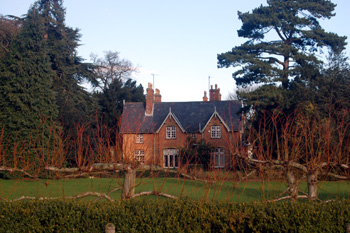Berrystead Eversholt

Berrystead November 2008
The Bedfordshire Historic Environment Record [HER] contains information on the county’s historic buildings and landscapes and summaries of each entry can now be found online as part of the Heritage Gateway website. The description for Berrystead [HER 14342] is as follows: “A large brick built construction it appears to have only been rendered on one side. The roof is tiled, mainly in fishscale tiles, and there is a number of gable ends that break through the eaves. The rendered elevation has casement windows with shutters attached to the windows in the main gable. There are two doors flanking this gable which have plain fanlights above them. The non-rendered elevations have casement windows with decorative glazing bars, as well as a bay window. A single storey extension has been added to the rear elevation which includes a bow window incorporating a door, these are flanked by columns. All the gables have a central finial”.
In the 19th century one of the owners and occupiers was prominent Woburn solicitor John Green. His practice in Woburn was carried on by his son, John Thomas Green and nephew Frederic Edward Tanqueray. In the mid 20th century the firm was acquired by Richard Holborn and a very large collection of the firm’s records dating back to the days of John Green is held by Bedfordshire Archives and Records Service under the mnemonic HN.
In 1911 the owner was Edward Aveling Green of Haverstock Hill, London. In his will [HN10/359/Green1] he gave his nephew Charles Dymoke Green first refusal on purchasing Berrystead, for £5,000.
The Rating and Valuation Act 1925 specified that every building and piece of land in the country was to be assessed to determine its rateable value. The valuer visiting Berrystead [DV1/C131/15] found that the owner and occupier was now Edward Green. Downstairs comprised: a hall (“very nice”); three reception rooms; a kitchen; a scullery; a larder and a pantry. Upstairs were seven bedrooms and a WC. Grounds extended over 2.5 acres.
Outside stood a brick and tiled dairy, knife house and coal shed, store, three stables and a double coachhouse. There were also timbered and thatched pigsties, an open hovel, a cow house, a store and workshop, a cart hovel, a potting shed and a small glass house. Green also owned around 7.5 acres of land divided into four fields adjoining the property. The valuer commented: “Lamps only. No Bathroom. Water from spring. Lovely situation. In 1932 C D Green sold Berrystead to the Duke of Bedford.